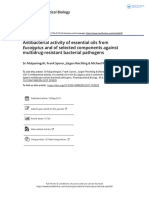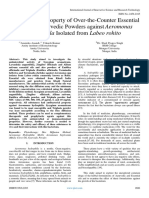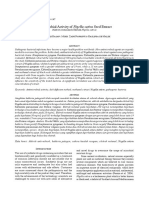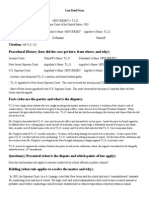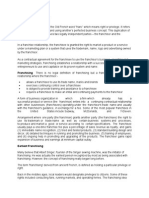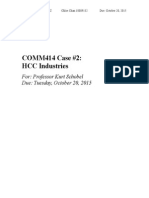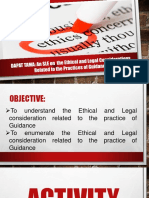27 Vol9
27 Vol9
Uploaded by
Amine BenineCopyright:
Available Formats
27 Vol9
27 Vol9
Uploaded by
Amine BenineOriginal Description:
Original Title
Copyright
Available Formats
Share this document
Did you find this document useful?
Is this content inappropriate?
Copyright:
Available Formats
27 Vol9
27 Vol9
Uploaded by
Amine BenineCopyright:
Available Formats
LUCRRI TIINIFICE MEDICIN VETERINAR VOL.
XLII (1), 2009, TIMIOARA
ANTIMICROBIAL POTENTIAL OF SOME LAMIACEAE
ESSENTIAL OILS AGAINST ANIMAL MULTIRESISTANT
BACTERIA
MIHAELA NICULAE, MARINA SPNU, CARMEN DANA ANDRU, F.
BRUDAC, D. CADAR, BIANCA SZAKACS, I. SCURTU, P. BOLF,
C.I. MATE
University of Agricultural Sciences and Veterinary Medicine, Faculty of Veterinary
Medicine, 3-5, Manastur Street, 400372, Cluj-Napoca, Romania
E-mail: niculaemihaela@hotmail.com
Summary
A considerable scientific interest is exhibited nowadays to the antimicrobial
screening of bioactive herbal extracts or constituents, due to their unique and complex
biological potential. The aim of the present study was to investigate the antibacterial
properties of some essential oils derived from several herb species belonging to Lamiaceae
family against animal pathogens well known for their elevate antibiotic resistance level:
Staphylococcus aureus, Salmonella enteritidis, E. coli and Pseudomonas aeruginosa. The
antimicrobial potential was determined performing the disc diffusion assay and also minimal
inhibitory (MIC) and bactericidal (MBC) concentrations were established by broth
microdilution method. The inhibitory ability manifested by the herbal products against the
bacterial strains varied significantly depending fundamentally on herbal source and
concentration, but also on bacterial species. The most resistant bacteria proved to be
Pseudomonas aeruginosa, with MIC and MBC values between 2 and 4% for the most active
herbal products. The results suggest that some of the screened herbal extractions could be
considered for further investigations regarding the therapeutic use in animal bacterial
pathology.
Key words: Lamiaceae essential oils, antimicrobial potential
The increasing occurrence of antimicrobial resistance represents a
worldwide major concern for both human and veterinary medicine (2, 6). Although
several strategies have been proposed to overcome and control this situation, still a
clear solution has not been found due to the antibiotic resistance complexity and
consequences and also considering the side effects of classic antimicrobial drugs.
A powerful trend recommends the herbal preparations to be investigated for their
antimicrobial activity. Therefore, nowadays, there is a growing interest in the
antimicrobial screening of extracts and essential oils from plants in order to
discover new antimicrobial agents. The Lamiaceae is one of the most diverse and
widespread plant families in terms of ethnomedicine and its medicinal value is
manly based on the volatile oils concentration (5). It is well documented that some
plants belonging to this family possess antimicrobial properties (6), however the
reported aspects are not constant.
170
LUCRRI TIINIFICE MEDICIN VETERINAR VOL. XLII (1), 2009, TIMIOARA
The objective of this research was to evaluate the potential of essential oils
derived from Thymus vulgaris, Salvia officinalis, Lavandula officinalis, Mentha
piperita, Rosmarinus officinalis, Ocimum basilicum, Mellisa officinalis and
Origanum vulgare against multi-drug resistant bacteria such as Staphylococcus
aureus, Salmonella enteritidis, E. coli and Pseudomonas aeruginosa which were
isolated from animal clinical cases. The antimicrobial potential was determined
performing the disc diffusion assay and also minimal inhibitory (MIC) and
bactericidal (MBC) concentrations were established by broth microdilution method.
Materials and methods
Plant extracts The present study included essential oils and/ or ethanol
extracts derived from plants belonging to Lamiaceae family: thyme (Thymus
vulgaris), common sage (Salvia officinalis), lavander (Lavandula officinalis),
peppermint (Mentha piperita), rosemary (Rosmarinus officinalis), sweet basil
(Ocimum basilicum), lemon balm (Mellisa officinalis) and oregano (Origanum
vulgare). All of them were purchased from commercial sources and Millipore filter
sterilized prior to antimicrobial assays.
Bacterial strains The set of microorganisms elected for this assay
included standard strains, Staphylococcus aureus ATCC 25923 and several
Staphylococcus aureus, Salmonella enteritidis, E. coli and Pseudomonas
aeruginosa strains isolated from animal clinical cases. These isolates, identified by
standard microbiological methods, were also screened for their susceptibility
towards antimicrobial agents, displaying different levels of antibiotic resistance. In
order to perform the antimicrobial screening, the bacterial isolates were cultured
overnight at 37C on Mueller Hinton agar (Oxoid). Colonies collected from each
twenty-four hours bacterial culture were diluted in sterile saline and the optical
density was adjusted according to the tube 0.5 of McFarland scale to prepare a
standardized inoculum (1.5 x 108cfu/ml).
Antimicrobial assay (Disc Diffusion Assay)
Each strain, prepared as a standardized inoculum, was inoculated on the
surface of Mueller Hinton agar plates (Oxoid). Subsequently, sterile filter paper
discs (Whatman, 6 mm diameter) containing approximately 20L of the herbal
essential oils were applied on and the plates were incubated overnight at 37C. The
study evaluated each herbal sample in triplicate. Discs of Amoxicillin + Clavulanic
Acid (20g +10g, BioMerieux) and enrofloxacin (5g, KRKA) were used as
positive controls, while sterile paper discs without herbal extractions were
considered as negative controls. After the incubation period, the diameters of the
inhibition zone were measured in millimeters and compared to those of the positive
controls.
171
LUCRRI TIINIFICE MEDICIN VETERINAR VOL. XLII (1), 2009, TIMIOARA
Minimum inhibitory concentration (MIC) and Minimum bactericidal
concentration (MBC) (broth dilution method)
The MIC and MBC were determined using the broth microdilution method
(1). Using Mueller Hinton broth, series of twofold dilutions of each essential oil were
performed in sterile 96-well microtiter plates. 100l of each dilution, ranging from
4% to 0.125% (v/v), were mixed with an equal volume of bacterial suspension.
Positive and negative growth controls were prepared. The plates were incubated
for 24h, at 37C, under normal atmospheric conditions. The MIC was defined as
the lowest concentration (highest dilution) of the herbal essential oils that inhibited
the visible growth (no turbidity), when compared to the control. Afterwards, 10l of
each well were transferred to Mueller Hinton agar plates and incubated for 24h, at
37C. The lowest concentration associated with no visible growth of bacteria on the
agar plates was considered the MBC. All dilutions were performed in duplicate.
Results and discussions
Our results, determined using disc diffusion and broth microdilution
methods, are presented as average values in tables 1 and 2.
Table 1
Inhibition zone diameter (d) in mm as established by disc diffusion method
(EO, essential oil; (-), no inhibition) (mean of three tests)
Plant used
Staphylococcus
aureus
Salmonella
enteritidis
E. coli
Pseudomonas
aeruginosa
Thyme
24
14
15
12
Sage
42
30
30
24
Lavander
38
28
28
25
Peppermint
38
27
28
24
Rosemary
36
25
24
10
Sweet basil
28
18
18
Lemon
balm
50
34
34
28
Oregano
35
30
30
172
LUCRRI TIINIFICE MEDICIN VETERINAR VOL. XLII (1), 2009, TIMIOARA
Table 2
MIC and MBC (% v/v) for the tested herbal products as established by both
microdilution methods) (mean of two tests)
Plant used
Staphylococcus
aureus
Salmonella
enteritidis
E. coli
Pseudomonas
aeruginosa
MIC
MBC
MIC
MBC
MIC
MBC
MIC
MBC
Thyme
0.125
0.125
0.125
0.125
Sage
0.125
0.125
0.125
0.125
Lavander
Peppermint
Rosemary
Sweet basil
>4
Lemon
balm
0.125
0.125
0.125
0.125
Oregano
>4
This study revealed significant differences in displaying the antimicrobial
potential for the herbal preparations tested. All the herbal species manifested
antibacterial properties, but the level of bacterial growth inhibition induced by plant
materials, as determined by the disc diffusion assay, proved to be dependent
mostly on herbal source and on bacterial strain.
By using disc method we observed that essential oils determined different
inhibition zones on tested bacteria. However, it was established that essential oils
of different Lamiaceae species had antibacterial effects both on Gram-positive
(Staphylococcus aureus) and Gram-negative bacteria (Escherichia coli, Salmonella
enteritidis and Pseudomonas aeruginosa). Lavandula officinalis, Mentha piperita,
Rosmarinus officinalis and Origanum vulgare displayed similar potential,
whileThymus vulgaris and Ocimum basilicum had the lowest effect on the bacteria
growth. Essential oil of Mellisa officinalis was the most active on the tested strains,
presenting the largest zones of growth inhibition among the sensible strains and
also possessing the lowest MIC and MBCs values.
Comparison of the sensitivity of tested bacteria towards the essential oils
showed that Gram-negative strains, especially Pseudomonas aeruginosa isolates,
were the most resistant. Regarding the strains of Pseudomonas aeruginosa, it was
observed that almost all of the tested substances (except the Ocimum basilicum
and Origanum vulgare essential oils) presented antibacterial activity, characterized
by the presence of zones of growth inhibition with diameters that varied from 10
mm (Rosmarinus officinalis) to 28 mm (Mellisa officinalis). On the other hand, the
most sensitive bacterium was Staphylococcus aureus.
The results obtained in the microdilution assay are well connected with the
above mentioned aspects.
173
LUCRRI TIINIFICE MEDICIN VETERINAR VOL. XLII (1), 2009, TIMIOARA
Most of the essential oils, case of Thymus vulgaris, Salvia officinalis,
Lavandula officinalis, Mentha piperita, Rosmarinus officinalis and Mellisa officinalis,
showed strong antimicrobial activity (both bacteriostatic and bactericidal effect)
against Staphylococcus aureus, Salmonella enteritidis and E. coli, at
concentrations that ranged from 0.125 to 2% (v/v). Mellisa officinalis essential oils
showed significant bactericidal effects against the bacterial strains tested, with
minimal bactericidal concentration 0.125% (v/v). Salvia officinalis essential oils also
displayed an antimicrobial activity, however, less efficient comparing to Mellisa
officinalis essential oils as MIC and MBC against the Pseudomonas aeruginosa
strains were 4% (v/v).
The use of plant extracts with known antimicrobial properties can be of
great significance in therapeutic treatments. In the last few years, a number of
studies have been conducted in different countries to prove such efficiency (2, 3,
6). Many plants have been used because of their antimicrobial traits, which are due
to compounds synthesized in the secondary metabolism of the plant. Several
studies indicate that the essential oils of the herbal belonging to Lamiaceae family
possess biological activity against several bacteria and yeast (2, 3, 5, 6). According
to them, there are differences in the activity of an essential oil to another or even of
their subproducts, due to the structure activity relationship. This discrepancy in
exerting the antibacterial potential may be caused by a variation that concerns the
chemical composition as this one is determined at a greater extent by the
distillation and extraction technique or by the different geographical chemotype.
This happens, probably because the essential oils are composed by,
several substances that can interact jointly in a synergic/potential form, giving them
strong antimicrobial activity (1, 2, 3). Other factor that should also be studied and
considered is related to the diffusion ability of the tested product in the culture
medium, which can favor in some situations, the diameter of the zones of growth
inhibition.
Many of the oil components may possess the ability to break or to
penetrate the lipid structure present in the Gram-negatives bacteria wall.
Due to its remarkable antibiotic-resistance, P. aeruginosa represents a
problem of increasing significance in veterinary medicine. According to our results,
susceptibility of Pseudomonas aeruginosa to most essential oils was relatively
poor, but we observed that the essentials oils obtained from Mellisa officinalis
seemed to manifest bacteriostatic and bactericidal activity against these bacteria.
Conclusions
All the screened Lamiaceae species showed antibacterial potential, but
with significant differences concerning the level of bacterial growth inhibition. The
antimicrobial activity seemed to be dependent mostly on herbal source and also on
bacterial genera. Mellisa officinalis demonstrated the strongest antimicrobial
efficacy against all bacterial strains. Also, Salvia officinalis, Rosmarinus officinalis
174
LUCRRI TIINIFICE MEDICIN VETERINAR VOL. XLII (1), 2009, TIMIOARA
and Lavandula officinalis essential oils possessed promising antibacterial
properties against animal multiresistant bacterial pathogens.
The results of this study showed that most of the essential oils presented
similar antimicrobial activity when challenged to a particular bacterial strain,
diverging discreetly in relation to the size of the zones of growth inhibition, as well
as to the MIC and MBC values.
These data suggest the potential application of some herbal preparations
alone or in combination with antibiotics for the treatment and prevention of
pathologies associated with multiresistant bacteria. Further investigations regarding
the in vitro and in vivo toxicity should be conducted in order to develop such
products.
References
1. Carson, C.F., Cookson, B.D., Riley, T.V., Susceptibility of methicillinresistant Staphylococcus aureus to the essential oils of Melaleuca alternifolia,
Journal of Antimicrobial Chemotherapy, 1995, 35, 421-424.
2. Delamare, A.P.L., Pistorello, I.T.M., Artico, Liane, Serafini, L.A.,
Echeverrigaray, S., Antibacterial activity of the essential oils of Salvia
officinalis L. and Salvia triloba L. cultivated in South Brazil, Food Chemistry,
2007, 100, 603-608.
3. Faleiro, M.L., Miguel, M.G., Ladeiro, F., Venancio, F., Tavares, R., Brito,
J.C., Figueiredo, A.C., Barroso, J.G., Pedro, L.G., Antimicrobial activity of
essential oils isolated from Portuguese endemic species of Thymus, Lett
Appl Microbiol., 2003, 36, 1, 35-40.
4. Pasqua R. di Feo, V. de Villani F., Mauriello G., In vitro antimicrobial
activity of essential oils from Mediterranean Apiaceae, Verbenaceae and
Lamiaceae against foodborne pathogens and spoilage bacteria, Annals of
Microbiology, 2005, 55, 2, 139-143.
5. Sarac, N., Ugur, A., Antimicrobial activities and usage in folkloric medicine of
some Lamiaceae species growing in Mugla, Turkey. EurAsia J BioSci, 2007,
1, 4, 28-34.
175
You might also like
- Medicinal Mushrooms: The Essential GuideFrom EverandMedicinal Mushrooms: The Essential GuideRating: 4.5 out of 5 stars4.5/5 (22)
- Antimicrobial Activity of Essential Oil Extract of Ocimum Basilicum L. Leaves On A Variety of PathogDocument4 pagesAntimicrobial Activity of Essential Oil Extract of Ocimum Basilicum L. Leaves On A Variety of PathogAna TorresNo ratings yet
- Rosemary AntibacterialDocument5 pagesRosemary AntibacterialNurul Izzah Wahidul AzamNo ratings yet
- Comparative Efficacy of Herbal Essences With Amphotricin B and Ketoconazole On CandidaDocument7 pagesComparative Efficacy of Herbal Essences With Amphotricin B and Ketoconazole On CandidaiisisiisNo ratings yet
- Pharmacological Activities of Essential Oil Extracted From Viola Patrinii Against Some Gram Positive and Gram Negative Bacteria As Well Fungal StrainsDocument6 pagesPharmacological Activities of Essential Oil Extracted From Viola Patrinii Against Some Gram Positive and Gram Negative Bacteria As Well Fungal StrainsInternational Journal of Innovative Science and Research TechnologyNo ratings yet
- F2204052833Document6 pagesF2204052833drbharathshivkumarNo ratings yet
- Phytochemical Screening and in Vitro Antimicrobial Activity of CombinedDocument4 pagesPhytochemical Screening and in Vitro Antimicrobial Activity of Combinededuard19941119No ratings yet
- Agar Well Diffusion MTDDocument7 pagesAgar Well Diffusion MTDRoland GealonNo ratings yet
- Penting AromadendeDocument8 pagesPenting AromadendeAizhuuaf TurquoiseNo ratings yet
- Quim. Nova,: Callistemon Viminalis PolandiiDocument5 pagesQuim. Nova,: Callistemon Viminalis PolandiiArchana JoshiNo ratings yet
- 10 5923 S Microbiology 201401 01Document9 pages10 5923 S Microbiology 201401 01Aksan IpeyNo ratings yet
- In Vitro Evaluation of The Antibiogramic Activities of The Seeds of Myristica FragransDocument6 pagesIn Vitro Evaluation of The Antibiogramic Activities of The Seeds of Myristica FragransAndry LarsenNo ratings yet
- Antimicrobial Property of Over-the-Counter Essential Oils and Ayurvedic Powders Against Aeromonas Hydrophila Isolated From Labeo RohitoDocument4 pagesAntimicrobial Property of Over-the-Counter Essential Oils and Ayurvedic Powders Against Aeromonas Hydrophila Isolated From Labeo RohitoInternational Journal of Innovative Science and Research Technology100% (1)
- PR 13110Document8 pagesPR 13110RyanNo ratings yet
- Antimicrobial Activity of Emilia Sonchifolia DC Tridax Procumbens Etc Potential As Food PreservativesDocument9 pagesAntimicrobial Activity of Emilia Sonchifolia DC Tridax Procumbens Etc Potential As Food Preservativessripathy84No ratings yet
- Antibacterial Activity of Phyto Essential Oils On Flaccherie Causing Bacteria in The Mulberry Silk Worm, B.Mori. LDocument5 pagesAntibacterial Activity of Phyto Essential Oils On Flaccherie Causing Bacteria in The Mulberry Silk Worm, B.Mori. LIOSRjournalNo ratings yet
- 12 2015cinamoncremfilledDocument7 pages12 2015cinamoncremfilledAlifia NurtianaNo ratings yet
- Bioactivity of Artemisia Herba Alba Essential Oil Against Plant Pathogenic FungiDocument7 pagesBioactivity of Artemisia Herba Alba Essential Oil Against Plant Pathogenic Fungisunaina agarwalNo ratings yet
- Kel 11 - PPT ANTIMIKROBIAL ACTIVITY OF FEW MEDICINAL HERBSDocument17 pagesKel 11 - PPT ANTIMIKROBIAL ACTIVITY OF FEW MEDICINAL HERBSSyafira IrtantiNo ratings yet
- 18 Dobre AlinaDocument7 pages18 Dobre Alinasukriti2812No ratings yet
- Antibacterial and Phytochemical Screening of Anethum GraveolensDocument10 pagesAntibacterial and Phytochemical Screening of Anethum GraveolensAida Fitriya HamzahNo ratings yet
- tmp9414 TMPDocument8 pagestmp9414 TMPFrontiersNo ratings yet
- Assessment of Antimicrobial Activity of Cassia Fistula and Flacoartia Indica Leaves.Document5 pagesAssessment of Antimicrobial Activity of Cassia Fistula and Flacoartia Indica Leaves.Eliana CaraballoNo ratings yet
- Me NTH ADocument4 pagesMe NTH ASoumitra NathNo ratings yet
- Fu 2007Document6 pagesFu 2007RékaNo ratings yet
- Medicinal Plants and Its Antimicrobial PDocument12 pagesMedicinal Plants and Its Antimicrobial PAbd almalik AlaromyNo ratings yet
- Neethu Article PDFDocument5 pagesNeethu Article PDFSarathchandran Chandrashekar ShenoyNo ratings yet
- Antibacterial Activity and Composition of Essential Oils FromDocument6 pagesAntibacterial Activity and Composition of Essential Oils FromkicmofsNo ratings yet
- BMC Complementary and Alternative Medicine: Antibacterial and Phytochemical Screening of Anethum GraveolensDocument10 pagesBMC Complementary and Alternative Medicine: Antibacterial and Phytochemical Screening of Anethum Graveolensmimi boukNo ratings yet
- The in Vitro Study of Antimicrobial Effect of Marigoldcalendula Officinalis Extract On Infectious MicroorganismsDocument5 pagesThe in Vitro Study of Antimicrobial Effect of Marigoldcalendula Officinalis Extract On Infectious MicroorganismsdssgssNo ratings yet
- Chemical Composition of 8 Eucalyptus SpeDocument15 pagesChemical Composition of 8 Eucalyptus SpeAlex osorioNo ratings yet
- Ajol File Journals - 82 - Articles - 82639 - Submission - Proof - 82639 973 198882 1 10 20121025Document8 pagesAjol File Journals - 82 - Articles - 82639 - Submission - Proof - 82639 973 198882 1 10 20121025yarach9494No ratings yet
- Antibacterial Activity of Lantana Camara Linn and Lantana: Montevidensis Brig Extracts From Cariri-Ceará, BrazilDocument3 pagesAntibacterial Activity of Lantana Camara Linn and Lantana: Montevidensis Brig Extracts From Cariri-Ceará, BrazilevilbioNo ratings yet
- LemonhandsanitizerDocument11 pagesLemonhandsanitizerJaz MiuraNo ratings yet
- Application of Essential Oils As Natural Cosmetic PreservativesDocument15 pagesApplication of Essential Oils As Natural Cosmetic PreservativesjosareforNo ratings yet
- Bozin 2007Document7 pagesBozin 2007salarjahan74No ratings yet
- Dilusi 3Document4 pagesDilusi 3IvanRizaMaulanaNo ratings yet
- WaelMohamedAbuEl WafaandWalaaSaidMohamedAbdEl AllDocument13 pagesWaelMohamedAbuEl WafaandWalaaSaidMohamedAbdEl AllCarl Ritchie TempleNo ratings yet
- Artikel JurnalDocument5 pagesArtikel Jurnalsalman fardNo ratings yet
- Cell Surface Hydrophobicity, and Production of Proteinase and Hemolysin in Candida AlbicansDocument0 pagesCell Surface Hydrophobicity, and Production of Proteinase and Hemolysin in Candida AlbicansAryanto DedyNo ratings yet
- Comparison of Antimicrobial Activities of Clove Oil & Its Extract On Some Food Borne MicrobesDocument7 pagesComparison of Antimicrobial Activities of Clove Oil & Its Extract On Some Food Borne MicrobesSeema YadavNo ratings yet
- 2007.60-64 Sereh Sebagai AntibakteriDocument5 pages2007.60-64 Sereh Sebagai AntibakteriDeni oktaviaNo ratings yet
- Mateen 2010Document6 pagesMateen 2010Leandro DouglasNo ratings yet
- TMPFB TMPDocument7 pagesTMPFB TMPFrontiersNo ratings yet
- Antimicrobial Activity of Medicinal Plants ThesisDocument4 pagesAntimicrobial Activity of Medicinal Plants Thesisgdeqlsief100% (2)
- M. M. Njire, N. L.M. Budambula and J. N. KiiruDocument13 pagesM. M. Njire, N. L.M. Budambula and J. N. KiiruthisisghostactualNo ratings yet
- Antifungal Activities of Origanum Oil Against: Candida AlbicansDocument8 pagesAntifungal Activities of Origanum Oil Against: Candida AlbicansAline MachadoNo ratings yet
- In Vitro Antimicrobial Screening of The Fruit Extracts of Two Syzygium Species (Myrtaceae)Document4 pagesIn Vitro Antimicrobial Screening of The Fruit Extracts of Two Syzygium Species (Myrtaceae)Nugroho Resty KazukiNo ratings yet
- Antimicrobial Activity of Nigella Sativa Seed ExtractDocument5 pagesAntimicrobial Activity of Nigella Sativa Seed ExtractDian Takwa HarahapNo ratings yet
- Ajol File Journals - 45 - Articles - 7100 - Submission - Proof - 7100 529 50370 1 10 20090320Document6 pagesAjol File Journals - 45 - Articles - 7100 - Submission - Proof - 7100 529 50370 1 10 20090320abenapapabiplangeNo ratings yet
- HOLETZ, Fabíola Barbiéri Et Al. Screening of Some Plants Used in The Brazilian Folk Medicine For The Treatment of Infectious Diseases.. 2002, Vol.97, n.7, Pp. 1027-1031. ISSN 0074-0276.Document5 pagesHOLETZ, Fabíola Barbiéri Et Al. Screening of Some Plants Used in The Brazilian Folk Medicine For The Treatment of Infectious Diseases.. 2002, Vol.97, n.7, Pp. 1027-1031. ISSN 0074-0276.Dian Fitri ChairunnisaNo ratings yet
- 1476 0711 12 26Document8 pages1476 0711 12 26Mandar RasaneNo ratings yet
- Provided For Non-Commercial Research and Education Use. Not For Reproduction, Distribution or Commercial UseDocument13 pagesProvided For Non-Commercial Research and Education Use. Not For Reproduction, Distribution or Commercial UseSilvana NurulfauziyyahNo ratings yet
- Chemical Composition and Antimicrobial Effect of TagutesDocument10 pagesChemical Composition and Antimicrobial Effect of TagutesArarsa LetaNo ratings yet
- Biological Investigations of Antioxidant-Antimicrobial Properties and Chemical Composition of Essential Oil From Lavandula MultifidaDocument6 pagesBiological Investigations of Antioxidant-Antimicrobial Properties and Chemical Composition of Essential Oil From Lavandula MultifidaladipupoNo ratings yet
- Antibacterial Effect of Cassia Fistula Extract On Pathogenic Bacteria of Veterinary ImportanceDocument5 pagesAntibacterial Effect of Cassia Fistula Extract On Pathogenic Bacteria of Veterinary ImportanceAsif MajeedNo ratings yet
- Translate Uts MikrobioDocument9 pagesTranslate Uts MikrobioReni ArpNo ratings yet
- Insecticides (Incl. Fungicides, Herbicides, Nematicides, Larvicides, Etc.)Document3 pagesInsecticides (Incl. Fungicides, Herbicides, Nematicides, Larvicides, Etc.)Riskha Febriani HapsariNo ratings yet
- Evaluation of Topical Gel Bases Formulated With VaDocument9 pagesEvaluation of Topical Gel Bases Formulated With VaSean Kerby PalimaNo ratings yet
- Pharmacology of Indian Medicinal PlantsFrom EverandPharmacology of Indian Medicinal PlantsRating: 5 out of 5 stars5/5 (1)
- Encyclopedia of Reconstruction EraDocument933 pagesEncyclopedia of Reconstruction EraEgziabher Bin JoAnn100% (2)
- Warehousing in India: National Summit OnDocument4 pagesWarehousing in India: National Summit OnDhaval DudhatNo ratings yet
- Flippy The Flowerpecker: Author: Garima Bhatia Illustrator: Garima BhatiaDocument42 pagesFlippy The Flowerpecker: Author: Garima Bhatia Illustrator: Garima BhatiaMd Merajul IslamNo ratings yet
- New Jersey V T L oDocument1 pageNew Jersey V T L oapi-257598923No ratings yet
- System: Installation and Maintenance ManualDocument60 pagesSystem: Installation and Maintenance ManualCid FreitasNo ratings yet
- 2018 Nissan Kicks enDocument8 pages2018 Nissan Kicks ennovkovic1984No ratings yet
- ER-09 Environmental Aspects Evaluation - UpdatedDocument15 pagesER-09 Environmental Aspects Evaluation - Updatedram dhukeNo ratings yet
- Chapter 12 (Saunders)Document13 pagesChapter 12 (Saunders)sdgdfs sdfsfNo ratings yet
- Full ReportDocument16 pagesFull ReportInnah A Jose Vergara-HuertaNo ratings yet
- Example EmailDocument2 pagesExample Emailaliharissyed9714No ratings yet
- Coal Handling PlantDocument39 pagesCoal Handling PlantMukhtar AlamNo ratings yet
- JntukDocument23 pagesJntukRaji GoprajuNo ratings yet
- HCC IndustriesDocument8 pagesHCC IndustriesChloe MillsNo ratings yet
- 2009 Longleaf Flatwoods ReserveDocument71 pages2009 Longleaf Flatwoods Reservebradley_waltersNo ratings yet
- Magic LAB Brochure IWS en 94000211 ScreenDocument13 pagesMagic LAB Brochure IWS en 94000211 ScreenVishal SalveNo ratings yet
- QuizDocument26 pagesQuizEram SheikhNo ratings yet
- Ethical Consideration in Guidance and CounselingDocument45 pagesEthical Consideration in Guidance and CounselingJohn Karl Fernando100% (1)
- Sociology For Business (SOC-201) : Bba 5 SemesterDocument87 pagesSociology For Business (SOC-201) : Bba 5 SemesterRajan SubediNo ratings yet
- Trojan BackdoorsDocument32 pagesTrojan BackdoorsSneha VermaNo ratings yet
- BA - Social Work (3 Years BSW)Document15 pagesBA - Social Work (3 Years BSW)Ananta ChaliseNo ratings yet
- The Trolley Dodgers: Case Study Group Albancis, Rodante Fuertes, Kate Rowie Patayan, DarleneDocument9 pagesThe Trolley Dodgers: Case Study Group Albancis, Rodante Fuertes, Kate Rowie Patayan, DarleneDarlene PatNo ratings yet
- 1 DESI 2022 Thematic Chapters Human Capital Dym9fab8y3imrqSQX0bQczXHt8 88765Document10 pages1 DESI 2022 Thematic Chapters Human Capital Dym9fab8y3imrqSQX0bQczXHt8 88765onlysims85No ratings yet
- Shop Talk Issue 0002Document2 pagesShop Talk Issue 0002Chicago Transit Justice CoalitionNo ratings yet
- Embodied Carbon Reduction Checklist For City Projects v1 2022 04 05Document3 pagesEmbodied Carbon Reduction Checklist For City Projects v1 2022 04 05Victor OkhoyaNo ratings yet
- Revisiting Eurocode 8 Formulae For Periods of Vibration and Their Employment in Linear Seismic AnalysisDocument13 pagesRevisiting Eurocode 8 Formulae For Periods of Vibration and Their Employment in Linear Seismic AnalysisAnonymous imkwF8N7TeNo ratings yet
- 3.4 (Complementary and Supplementary Angles)Document4 pages3.4 (Complementary and Supplementary Angles)Kristel Mae MaligayaNo ratings yet
- ED 703 Centralized and Decentralized PlanningDocument32 pagesED 703 Centralized and Decentralized PlanningRitz SantiagoNo ratings yet
- S-1504 Pump Data Sheet 3 PhaseDocument1 pageS-1504 Pump Data Sheet 3 PhaseHoonNo ratings yet
- ATE 1211 Final Exam Question With Explanations of Answers Latest Update 2024 - 2025Document21 pagesATE 1211 Final Exam Question With Explanations of Answers Latest Update 2024 - 2025decotienoNo ratings yet
- 108 Spouses Abad v. CADocument2 pages108 Spouses Abad v. CALawdemhar CabatosNo ratings yet








